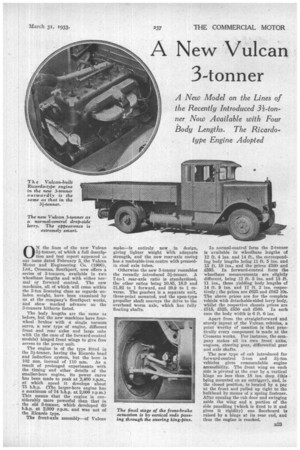A New Vulcan 3-tonner
Page 37

If you've noticed an error in this article please click here to report it so we can fix it.
A New Model on the Lines of the Recently Introduced ..M.tonner Now Available with Four Body Lengths. The Ricardo type Engine Adopted
ON the lines of the new Vulcan 31-tonner, of which a full description and test report appeared in our issue dated February 3, the Vulcan Motor and Engineering CO. (1906), Ltd., Crossens, Southport, now offers a series of 3-tonners, available in two wheelbase lengths and with either normal or forward control. The new machines, all of which will come within the 3-ton licensing class as regards unladen weight, have been examined by us at the company's Southport works, and show marked advance on the
3-tonners hitherto listed. . 17he body lengths are the same as before, but the new machines have fourwheel brakes with a single vacuum servo, a new type of engine, different front and rear axles and large cabs with (in the case of the forward-control models) hinged front wings to give free access to the power unit.
The engine is of the type fitted in the 31-tormer, having the Ricardo head and induction system, but the bore is 102 rum, instead of 110 mm. As a result of prolonged experiments with the timing and other details of the smaller-bore engine, its power curve has been made to peak at ,2,400 r.p.m., at which speed it develops about 75 b.h.p. (The larger-bore engine has a maximum of 74 b.h.p. at 2,000 r.p.m.) This means that the engine ia considerably more powerful than that in the old 3-tonner, which developed 60 b.h.p. at 2,000 r.p.m. and was not of the Ricardo type.
The front-axle assembly—of Vulcan
make—is entirely new, in design, giving lighter weight with adequate strength, and the new rear-axle casing has a malleable-iron centre with pressedin steel axle tubes.
Otherwise the new 3-tonner resembles the recently introduced n-tonner. A 7-to-1 rear-axle ratio is standardized, the other ratios being 10.85, 18.9 and 31.92 to 1 forward, and 39.9 to 1 reverse. The gearbox is a separate unit, three-point mounted, and the open-type propeller shaft conveys the drive to the overhead worm axle, which has fully floating shafts. In normal-control form the 3-tonner is available in wheelbase lengths of 12 ft. 4 ins. and 14 ft., the corresponding body lengths being 11 ft. 5 ins. and 13 ft. 10 ins., and the prices £580 and £595. In forward-control form the wheelbase measurements are slightly different, being 32 ft. 3 ins. and 13 ft. 11 ins., these yielding body lengths of 14 ft. 9 ins, and 17 ft. 2 ins, respectively; the prices are 1625 and 1642 10s. The above prices are for the complete vehicle with detachable-sided lorry body, whilst the respective chassis prices are £515, £525, £550 ana £560. In each case the body width is 6 ft. 6 ins.
Apart from the straightforward and sturdy layout of the Vulcan vehicles, a point worthy of mention is that practically every component is made at the Crossens works. For instance, the company makes all its own front axles, engines, steering gear, differential gear and axle shafts.
The new type of cab introduced for forward-control 3-ton and Si-ton. vehicles gives commendable engine accessibility. The front wing on each side is pivoted at the rear by a vertical hinge no less than 18 ins. deep (this being mounted on an outrigger), and, in the closed position, is located by a peg at the front and pulled up tight to the bulkhead by means of a spring fastener. After opening the cab door and swinging aside the wing and a portion of the side panelling (which is fixed to it and gives it rigidity) one floorboard is raised by a hinge at its rear end, and thus the engine is reached.




























































































